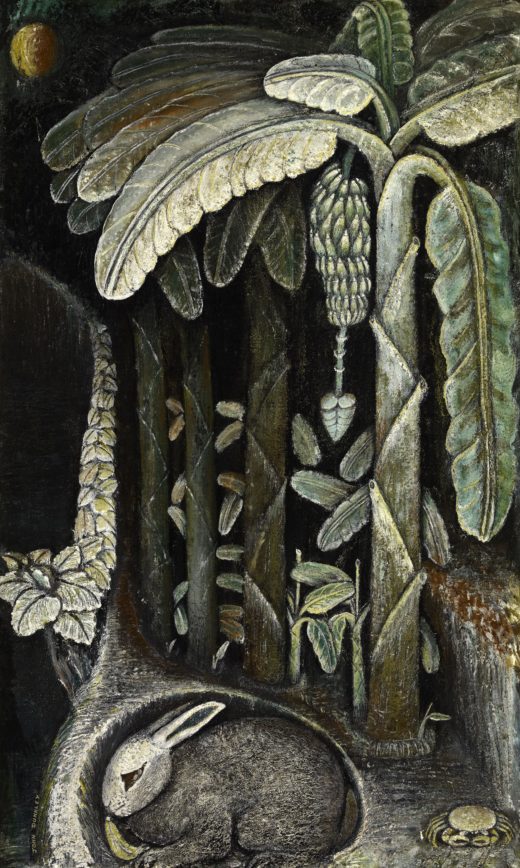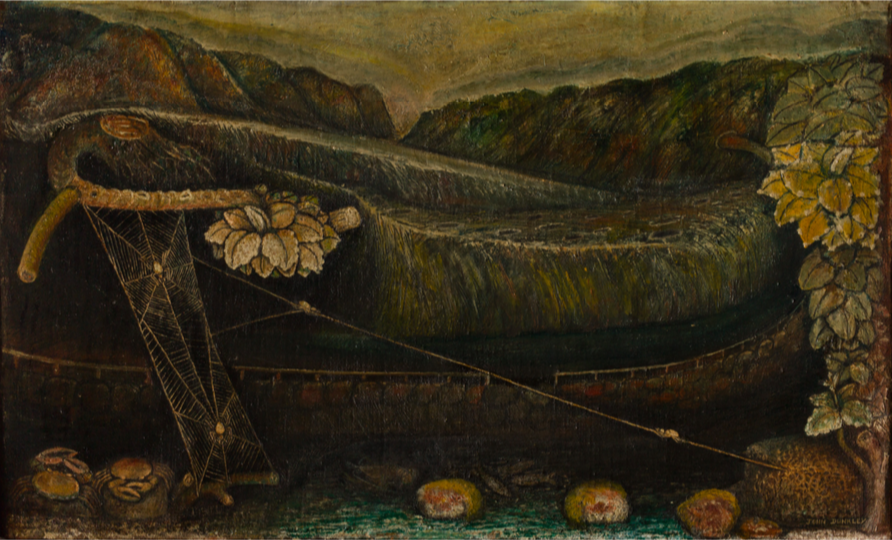- Pageslayers lays down literary roots in the Opa-Locka community

- Between New York and Tehran: Directory of Portrayals
John Dunkley: Neither Day Nor Night
Veerle Poupeye
 John Dunkley. Banana Plantation, ca. 1945. Mixed media on plywood, 29 1⁄8 x 17 5⁄8 inches. National Gallery of Jamaica, Kingston, gift of Cassie Dunkley. Photo: Franz Marzouca
John Dunkley. Banana Plantation, ca. 1945. Mixed media on plywood, 29 1⁄8 x 17 5⁄8 inches. National Gallery of Jamaica, Kingston, gift of Cassie Dunkley. Photo: Franz Marzouca
May 26-2017 — January 14, 2018
John Dunkley: Neither Day nor Night, which is on view at Perez Art Museum Miami (PAMM) until January 14, is the first comprehensive exhibition of the work of the Jamaican painter and sculptor John Dunkley since his retrospective at the National Gallery of Jamaica (NGJ) in 1976.
I should declare interest: I serve as the Executive Director of the National Gallery of Jamaica (NGJ), where I have also worked as a curator, and several Dunkleys from our collection are included in Neither Day nor Night.
John Dunkley was born in 1891 in the small port town of Savanna-la-Mar in the south-west of Jamaica and he died in Kingston in 1947. As a young man, and like many young black men from the Caribbean at that time, Dunkley travelled as a migrant worker to Panama, Costa Rica, and Cuba and also worked as a sailor. There are conflicting accounts as to when exactly Dunkley returned to Jamaica but by the early 1930s he ran a barber shop on Princess Street, in the heart of what was then the harbour and market district of Kingston. Dunkley was self-taught as an artist and the painted and sculpted decorations he produced for his barber shop attracted the attention of the Institute of Jamaica’s Secretary Hender Delves Molesworth (a young Englishman who later became Keeper of Sculpture at the Victoria and Albert Museum).
Dunkley was soon recognized as a unique and remarkable artistic talent but he remained an outsider. He appears to have preferred it that way—the story goes that he was invited to the art classes that were offered at the Institute by Edna Manley, a principal figure in Jamaica’s nationalist modernist school, but declined, stating that he saw things “a little differently.” 1 Today, Dunkley is recognized as a key figure in 20th century Jamaican art, and he is regarded as a major exponent of what the NGJ’s foundational Director/Curator David Boxer in the late 1970s coined as “Intuitive art,” as a more palatable alternative to “primitive” or “naïve.”
What sets Neither Day nor Night apart from other recent museum exhibitions dedicated to historical Caribbean artists is that Dunkley’s work is the sole subject of that exhibition, instead of being treated as a case study for an historical (or art-historical) moment relevant to the Caribbean. Being regarded on its own terms is a privilege that is still rarely granted to the work of artists from the Caribbean and it is gratifying that this was accorded to Dunkley (and that this was done without ignoring his contexts, which is explored in the catalogue essays). PAMM has consistently taken a thoughtful curatorial approach to art from the Caribbean and its diaspora and this has made the museum an increasingly influential voice in the conversations that shape this field.
 John Dunkley. Spider’s Web, n.d. Mixed media on canvas, 17 1⁄8 x 28 3⁄4 inches. Collection of Ernest, Kenneth J., and Tina Dunkley. Photo: Mariela Pascual
John Dunkley. Spider’s Web, n.d. Mixed media on canvas, 17 1⁄8 x 28 3⁄4 inches. Collection of Ernest, Kenneth J., and Tina Dunkley. Photo: Mariela Pascual
Neither Day nor Night is a compact exhibition, presented in a single gallery space, consisting of 48 paintings and sculptures; a representative overview of Dunkley’s small oeuvre. I had misgivings about how Dunkley’s small works would fare with the stark interior architecture of PAMM, which is more suitable for large contemporary works. Despite my hesitancy, the exhibition works well in the space with a judiciously placed mobile wall in the middle of the gallery and inspired thematic groupings that provide viewers with a richly immersive experience of Dunkley’s paintings and sculptures.
Dunkley’s paintings are worlds unto themselves, and while they are at least in part based on observed realities in Jamaica, Cuba and Central America, landscapes such as Banana Plantation and Spider’s Web (n.d.) have rightly been described as “landscapes of the mind.” They present a dark, brooding vision of the tropics, in which narrow gorges and gullies are populated with oversized vegetation and mysterious, nocturnal creatures, such as crabs, spiders, and rabbits, and it is impossible not to notice the phallic and vaginal allusions in the imagery. Dunkley’s landscapes may seem claustrophobic, but their visual density is intersected by winding paths that draw the eye into the depths of the painting, and into the unknown. Dunkley appears to have been preoccupied with the cycles of life—fertility and mortality—and a related theme in his work seems to be the tension between the indomitable forces of nature and humankind’s often-futile efforts to get the upper hand. This may have been influenced by his sojourn in Central America, where he witnessed one of the most ambitious mega-engineering feats in history, the construction of the Panama Canal, which was beset by calamities and cost some 25,000 human lives, as well as by his own experience with illness (Dunkley died at age 55 of what appears to have been lung cancer).
Neither Day nor Night also draws attention other important aspects of Dunkley’s work. One is the significance of his sculpture, which is often overlooked in favour of his paintings. The figure carvings are particularly poignant and not only reveal Dunkley’s erotic obsessions—his preoccupation with women’s shoes is decidedly fetishist and the contortionist figure of Acrobat (n.d.) simultaneously alludes to sexuality and birth—but they also illustrate Dunkley’s remarkable, expressive use of three-dimensional space. In his paintings, there is a strong tension between the two-dimensional surface and the almost vertiginous three-dimensional illusions within, but there is a similar tension in some of his carvings: Acrobat is a form turned in on itself in an Escher-like fashion and Woman on Horse, with its double-faced head of the woman and fused front legs of the horse, is a sculpture in the round that somehow, surreally refuses to be a sculpture in the round.
The exhibition also highlights Dunkley’s preoccupation with current affairs and illustrates that his work, which may at first appear to be a-historical, was well-grounded in the Jamaican experience of modernity. Barbershops throughout the African Diaspora function as community gathering spots where lively discussions are held about the issues of the day. Dunkley’s shop appears to have been no different, which must have influenced his artistic subjects, but his position on these subjects is cryptic and ambivalent. His portrait of one of the fathers of modern Jamaican politics, Alexander Bustamante, in The Good Shepherd (n.d.), is at first sight a picture of benevolent, charismatic leadership. The sheep flocked around the towering figure of Bustamante also suggest that his followers were passive and easily manipulated, while the few stray sheep that are seen escaping into the back of the painting remind us that there was dissent (and reveal a dark sense of humour evident in other Dunkley works.) Other works allude to Dunkley’s social position in late colonial society in Jamaica. His depictions of tennis and horseback riding provide a glimpse of a world from which someone like Dunkley would have been excluded, but in which his patrons, such as Molesworth and Edna Manley, were perfectly at home.
In the Caribbean, monographs on major artists are rare and, where they exist, they often lack critical depth. The catalogue of Neither Day nor Night is therefore an important addition to the literature on art from the Caribbean and contains three essays: the curatorial introduction by Diana Nawi and Nicole Smythe-Johnson, an essay by David Boxer, who served as curatorial advisor to the exhibition, and a shorter essay by Olive Senior, a Jamaican poet and historian of the Panama Canal.
Boxer’s essay explores Dunkley’s iconographic and stylistic sources in considerable detail. This represents an interesting reversal from how Boxer had previously framed Dunkley, as an artist who presented a largely unmediated inner vision—a purist conception of intuitive art which is usually untenable as it disconnects artists from their cultural context. While I am skeptical of inserting Dunkley into the art-historical genealogies that Boxer now proposes, which includes artists such as William Blake, Michelangelo, and El Greco, it is obvious that Dunkley was visually literate and liberally drew from those visual resources that were available to him, including the art books at the Institute of Jamaica library. It is also clear that Dunkley looked at his environment in a way that was mediated by its representational histories and Boxer’s comparisons with early Jamaican photographs and postcards are particularly useful in that regard. More obvious art-historical sources, such as Samuel Palmer and Albert Pinkham Ryder, are not mentioned, which is surprising since Boxer had acknowledged them in earlier writings on Dunkley.
Boxer’s essay may also overstate Dunkley’s reliance on the guidance of his patrons in the development of his work and, as I have argued elsewhere, it is one of the contradictions of the intuitive art construct that the work of such artists is presented as pure and unmediated but necessarily guided and defined by “knowing” patrons. This contradiction is addressed in the essay by Nawi and Smythe-Johnson, who raise the important question of Dunkley’s subaltern position and apparent lack of a voice in the discourse around his work. As they rightly argue, Dunkley’s voice is powerfully present in his art, which is why it is fortuitous that his work is represented in the exhibition without being overdetermined by context or interpretation. Senior’s essay follows a similar line of thought and evocatively places Dunkley in the social and cultural milieu of Caribbean migrant labour in the first half of the 20th century. She deftly argues that Dunkley was, without contradiction, a man of his time and a unique, visionary artist, whose work reflected his experiences of a particular historical moment but who, as she puts it, “turned his sublime vision into unforgettable art.”
Veerle Poupeye is a Belgium-born art historian and curator who is based in Jamaica and specialises in the art and visual culture of the Caribbean. She has published widely on the subject and is presently the Executive Director of the National Gallery of Jamaica.
Notes
1 David Boxer. Modern Jamaican Art. Kingston: National Gallery of Jamaica, 1998, p17
2 David Boxer. “Jamaican Art 1922-1982.” Modern Jamaican Art, Kingston: Ian randle, 1998, p16









